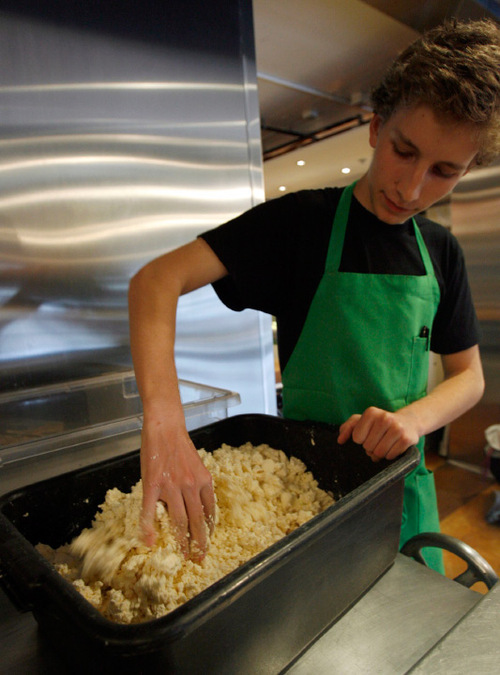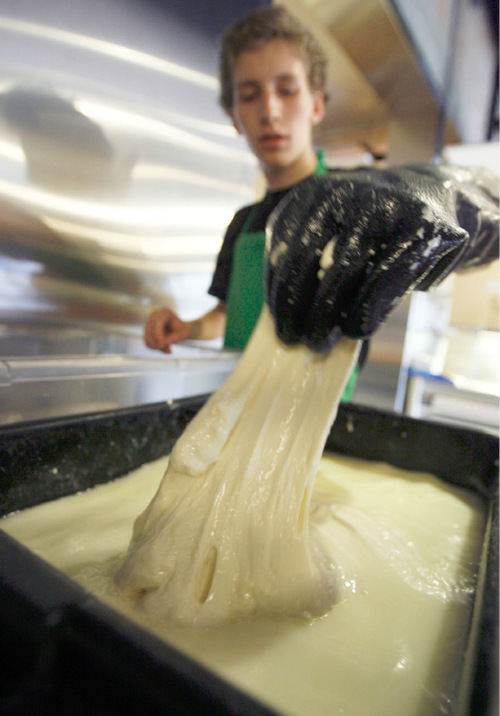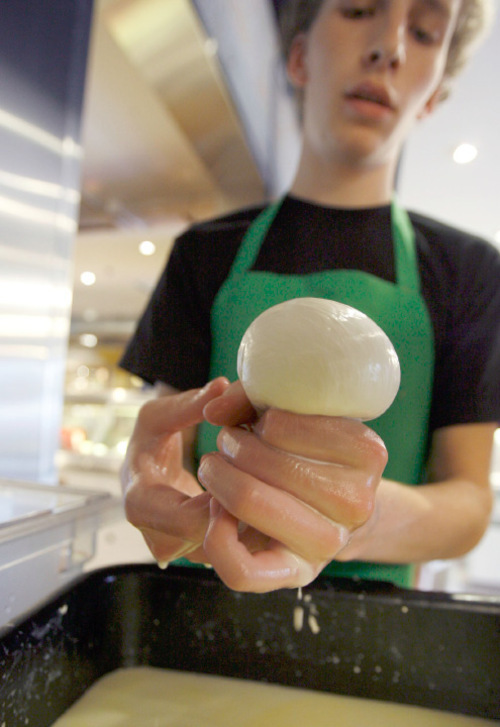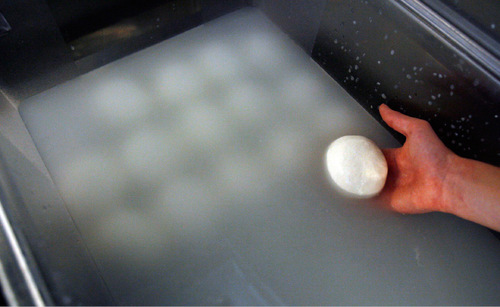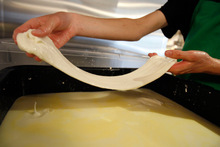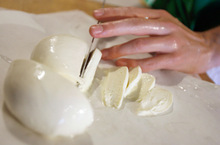This is an archived article that was published on sltrib.com in 2010, and information in the article may be outdated. It is provided only for personal research purposes and may not be reprinted.
There are the usual teen jobs — flipping hamburgers, babysitting and mowing the neighbor's lawn. Then there is 16-year-old Steve Floor's after-school assignment — making fresh mozzarella cheese.
The Highland High School student has been the official "magic mozz maker" at Tony Caputo's Market and Deli in downtown Salt Lake City for about two months, producing 80 to 100 pounds of the fresh cow's milk cheese each week.
Impressive for someone who just earned a driver's license.
Not long ago, Floor worked an after-school job at Emigration Market. But when the locally owned store closed earlier this year, he sought new employment at Caputo's. Initially he was working behind the counter and doing whatever odd jobs needed to be done.
One day, the inventory manager — who also happened to be in charge of making the fresh mozzarella — introduced Floor to cheesemaking.
His first batch of mozzarella was a little dry. The second needed a bit more salt. But after that, owner Matt Caputo was so impressed he gave the high school junior the mozzarella-making assignment.
Making mozzarella
To keep up with demand, Floor leaves school early several times each week on a "work release." He also works Saturdays, making fresh mozzarella as fast as customers buy it. That, says Floor, can be a bit intimidating.
However, no one would guess Floor has such feelings as he calmly and methodically goes about making this mild, white cheese that originates in southern Italy.
"It's a tradition that developed 400 years ago," said Floor. "It's exciting to keep the tradition going here. You don't find that everywhere."
One batch only takes about 30 minutes to make. To start, Floor immerses popcorn-sized cheese curds into a large tub filled with "almost boiling" water. Then he gently folds or "stretches" the melting curds, which creates the trademark stringy texture.
When there are no more lumps and the curds have formed one large mass resembling bread dough, Floor starts pinching off half-pound balls of cheese. He gently smooths and shapes each one and places it in a tub of ice water to set.
"The key," said Floor, "is really hot water (to melt the curds) and really cold water," which helps them keep their ball-like shape.
While not every batch tastes the same, the cheese always has a fresh, homemade flavor.
"You don't get that with cheese made from a machine," said Caputo.
Cheesemaking at home
Because the process is relatively simple, more and more home cooks are making fresh cheeses at home, says Raeleen Maxfield, owner of Mama Rae's Cheesemaking Supply in Orem.
Maxfield, whose family owns several milking cows, has been making cheese — as well as butter, sour cream and cottage cheese — for her family for many years. Besides selling supplies, she also gives monthly cheesemaking classes in Payson.
Over the last few years, she has seen a greater interest in making cheese.
"With the economic down turn, people want to do what they can to save money," she said during a recent class at Viking Cooking School. The course, sponsored by Wasatch Community Gardens, attracted nearly three-dozen cooks who learned to make queso blanco (white cheese), mozzarella and fermented products such as sauerkraut and kombucha, a fermented tea.
"The beauty of this cheese is that it is so simple," Maxfield said of the queso blanco. Indeed, only three ingredients are needed: hot milk, vinegar or lemon juice (for curdling) and salt for flavor. (Her recipe accompanies this story.)
Like many in the class, Katherine Allred of Salt Lake City, is trying to avoid processed foods in favor of fresh, homemade items.
"There's such as allure about making your own food," said the Salt Lake mother of four. "I can't milk my own cow, but I like feeding my children foods I've made from scratch."
Besides, she said, "I'm obsessed with cheese. I eat it at night in bed."
As for Floor at Caputo's, he too prefers the taste of his fresh mozzarella to pre-packaged offerings.
"My mom made lasagna using my cheese and Creminelli sausage," he said. "It turned out really good."
The cheesemaking experience has likely set Floor on his ultimate career path.
"The food business," he said, "is something I want to stick with."
Queso blanco (white cheese)
1 gallon whole milk*
1/4 cup vinegar (any kind will work including white, apple cider, balsamic, garlic and rice)**
1/2 teaspoon salt, or more to taste
Special equipment:
Stainless steel pot
Stainless steel spoon
Stainless steel strainer
Muslin or fine cheesecloth
Pour milk into a large stainless steel stock pot. Heat milk over medium to medium-low heat until it reaches 185 to 195 degrees, stirring as needed so the milk does not scorch the bottom of the pot. Remove from heat and slowly drizzle 1/4 cup vinegar into the milk, stirring gently with a clean stainless steel spoon until white curds form and separate from the yellowish-colored whey.
Place a stainless steel strainer over a large bowl in the sink. Line the strainer with muslin or fine cheesecloth. Pour the curds into the cheesecloth, letting the whey drip into the bowl below. Gather up the ends of the fabric and squeeze out any excess moisture.
Open up cloth and place cheese curds in a bowl. Season with desired amount of salt; start with 1/2 teaspoon and adding more if desired.
Divide cheese in half and press into two containers or molds. Cover with plastic wrap and refrigerate for several hours. Use cheese in pastries and Mexican-type dishes. This queso blanco becomes soft when heated, but does not melt.
Use cheese within one week.
*Maxfield said the best milk for cheesemaking is raw milk. If that is not available — or you have health concerns, use milk that has been pasteurized, but not homogenized.
**For queso fresco, substitute lemon juice for vinegar.
Servings • 1 pound
Source: Raeleen Maxfield, owner Mama Rae's Cheesemaking Supply, Orem —
Mozzarella cheese
1 1/2 teaspoon citric acid
1/4 plus 1/8 teaspoon liquid rennet*
1 gallon plus 1 quart whole milk
1 teaspoon salt
Dissolve the citric acid in 1/4 cup water. In another container, mix rennet with 1/4 cup water.
Pour milk into a large heavy-bottomed stainless steel pan. (Do not use aluminum or copper.) Place on the stove and stir in the citric acid solution. Heat the milk to 88 degrees.
Add the rennet and turn off the heat. Gently stir for about 1 minute. Allow mixture to sit undisturbed for 40 minutes.
Once the curd has formed, cut the curd into 1-inch squares.
Stir the curd while gradually heating the milk mixture to 98 degrees. Hold the temperature at 98 degrees and continue to gently stir 15 minutes. Do not allow milk to get hotter than 98 degrees.
Strain curd through a fine-mesh strainer and place in a microwave safe bowl. Heat curd 15 seconds in the microwave and drain off any excess whey.
Continue heating the curd in 15-second increments (and draining) until it begins to melt slightly. Remove the cheese from the bowl and knead in salt. Continue kneading, like you would bread, until the cheese becomes smooth and shiny. Be careful not to burn yourself while kneading, as the cheese will be warm.
*Rennet, a natural enzyme that helps curdle milk, is available in many supermarkets in the pudding section. Or you can buy liquid rennet from a cheesemakers supply house or website.
Servings • About 1 pound
Source: Chef Bryan Woolley —
Ricotta cheese
1 gallon whole milk
1 1/2 teaspoons citric acid
1 teaspoon salt
Special equipment
Stainless steel pot
Muslin or fine cheesecloth
Add milk, citric acid and salt to a heavy bottomed stainless steel pan. (Don't use aluminum or copper.) Heat mixture, stirring occasionally, to 200 degrees. At this temperature the curd and whey will separate.
Turn heat off and allow milk cool to 100 degrees. Strain through a cheesecloth and then tie the cheesecloth and allow the cheese to drain for an additional 20 minutes.
Servings • About 1 pound
Source: Chef Bryan Woolley —
Cheesemaking classes
Raeleen Maxfield, owner of Mama Rae's Cheesemaking Supply, offers cheesemaking classes on the first Wednesday and third Thursday of every month. Classes start at 7 p.m. and end about 9:30 p.m. and are held at 996 W. 800 South, in Payson. Cost is $10 per person. For more information visit: http://sites.google.com/site/mamaraescheesemakingsupply



